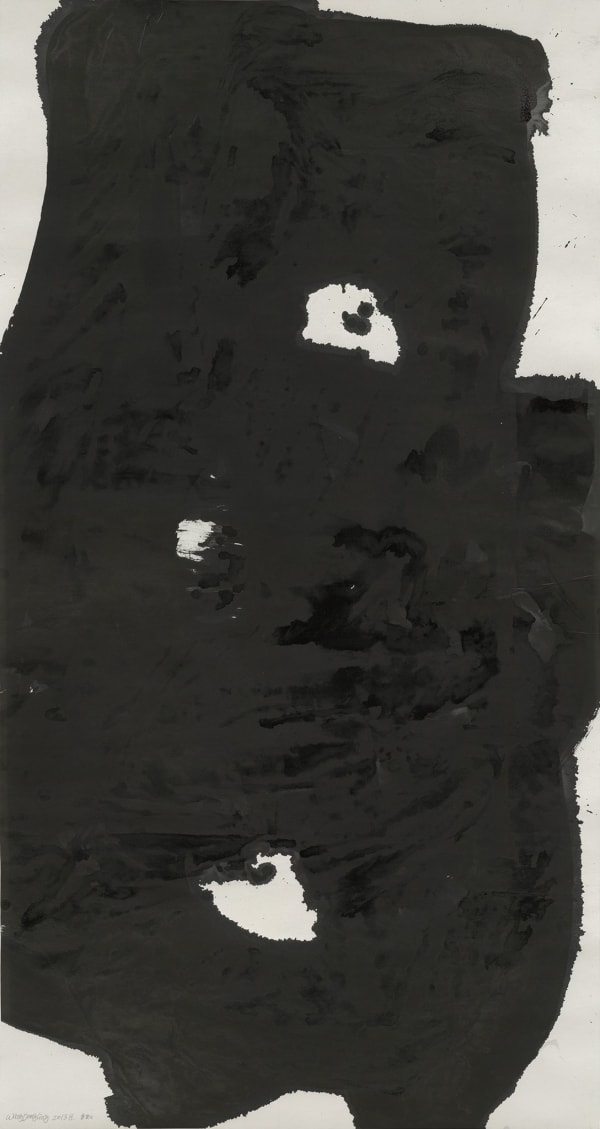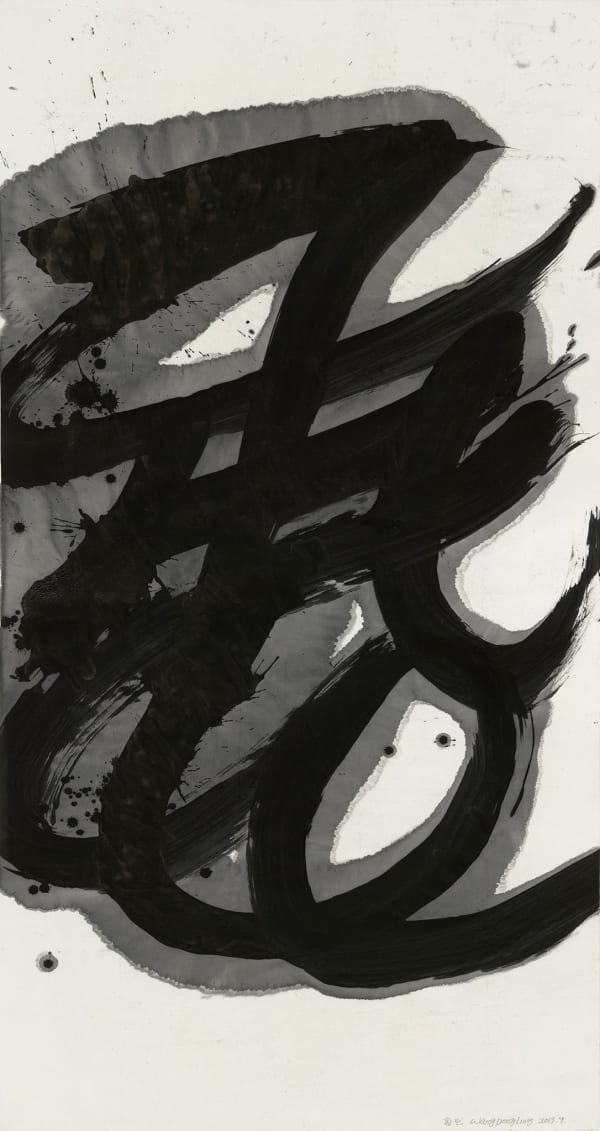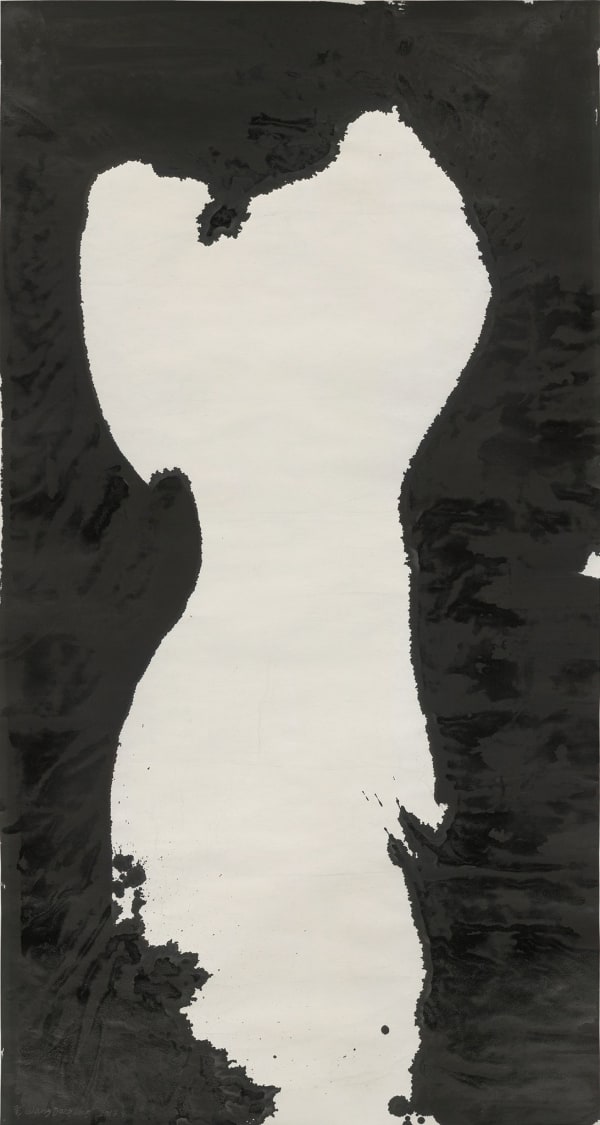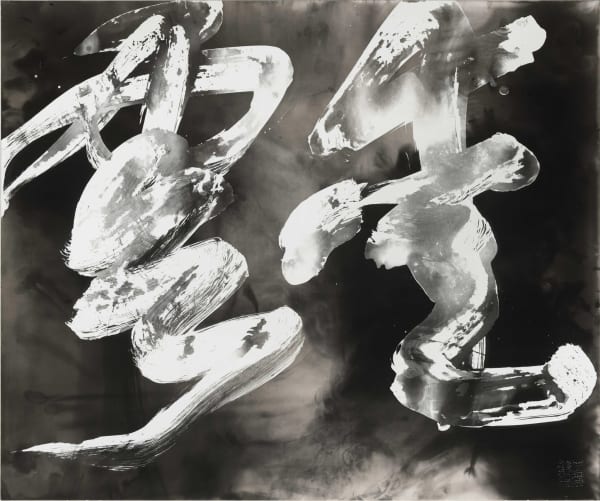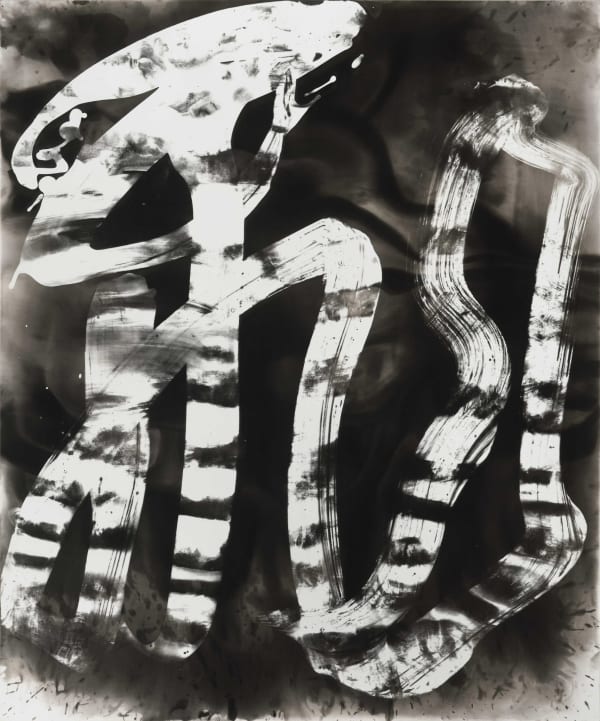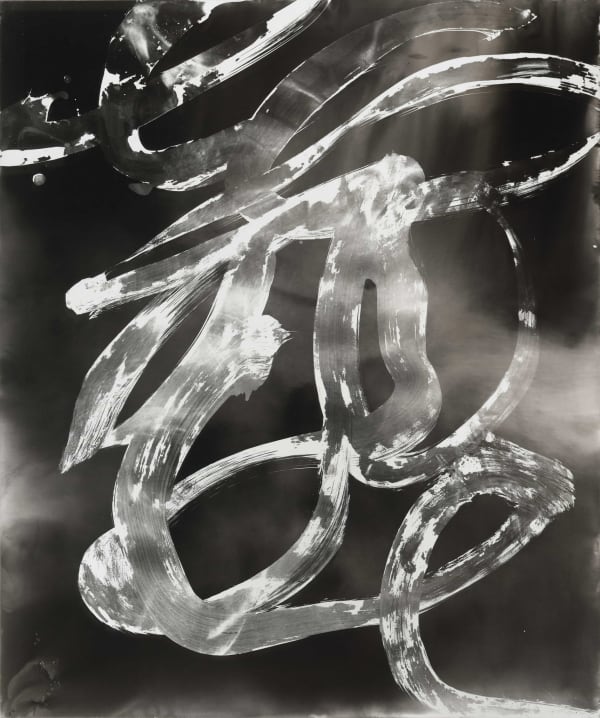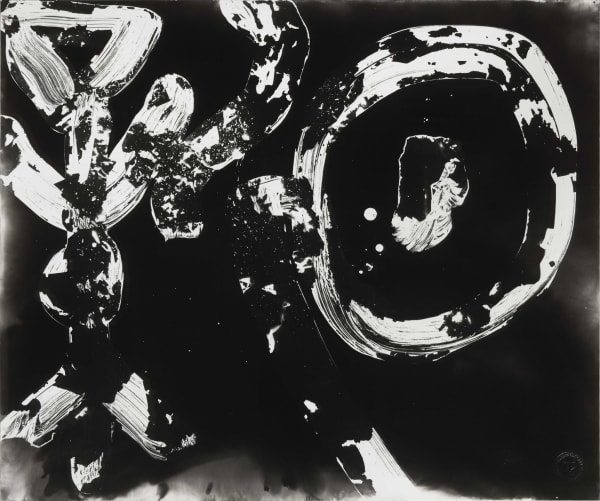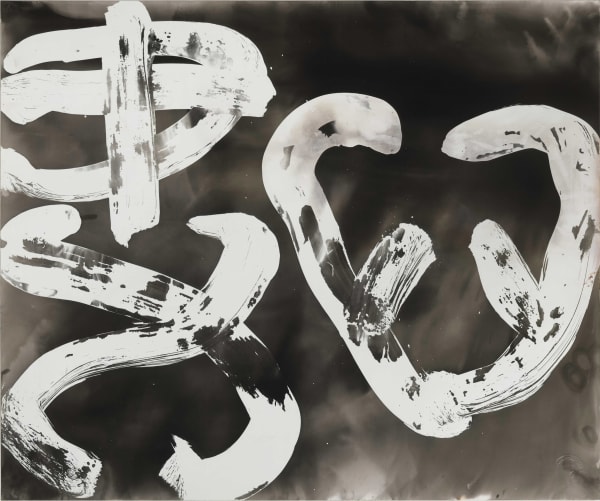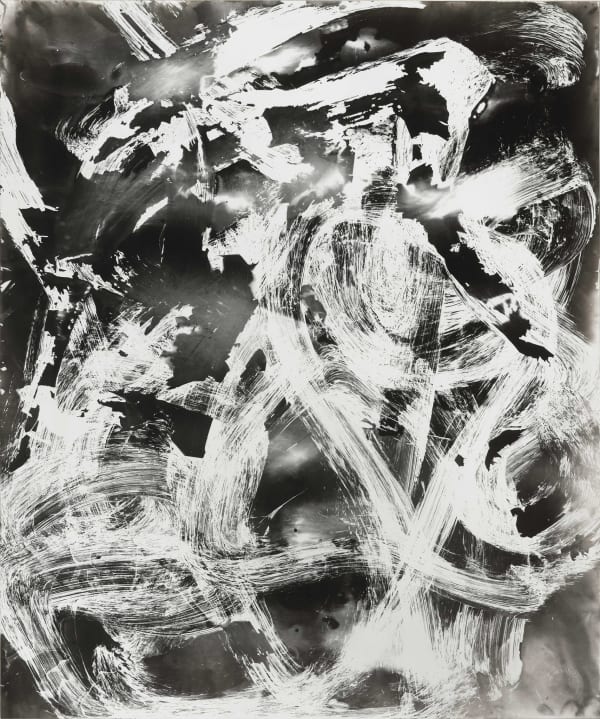THE ORIGINS OF ABSTRACTION: WANG DONGLING
Installation Video
Works can fall short of one's ideals, but a successful work must embody my true feelings because this work is not created by my hand but by my heart. (2006)
The Beijing art gallery Ink Studio is delighted to announce its third exhibition: The Origins of Abstraction: Wang Dongling's Abstract Ink Painting and Photographic Calligraphy.
Wang Dongling 王冬龄 (b. Rudong, Jiangsu, 1945) is uniquely important as a visionary artist whose practice is eminently rooted in the traditional art of calligraphy, but who is also working towards expanding the place of calligraphic art onto a global plane. As he has stated:
A modern calligrapher engaged in artistic creation should consider how to modernize creation in the art of calligraphy, to bring calligraphy to the world and allow it to expand into the realm of modern art. (2009)
Director of the Modern Calligraphy Study Center at the China National Academy of Fine Arts, Wang Dongling is widely regarded as one of China's greatest living calligraphers, belonging to a lineage of twentieth century masters including Lin Sanzhi 林散之 (1898-1989), Lu Weizhao 陆维钊 (1899-1980), and Sha Menghai 沙孟海 (1900-1992). His artistic practice embraces the traditional calligraphy for which he is best known, as well as highly experimental works including abstract painting based on calligraphic gesture, performance art that brings calligraphy into site-specific contexts, and camera-less photography that captures calligraphic actions on photographic paper.
I have been involved in both traditional calligraphy and in creative experiments in modern calligraphy, at the same time as exploring abstract painting. I feel these experiences can be complementary. Traditional calligraphy skills are crucial, and only when one has skills in traditional calligraphy can one be truly innovative and achieve expression and breakthroughs in modern calligraphy. At the same time, I also believe that a person with good training in calligraphy is able develop a unique artistic language and style in the creation of abstract art. (2009)
For Ink Studio's Origins of Abstraction exhibition, Wang Dongling has created a special body of work that demonstrates the power of the artist's revolutionary redirection of traditional calligraphy techniques into "modern calligraphy" and line-based abstraction. The exhibition will include a rare, extremely large abstract work by the artist, as well as a modern calligraphy series rendered in a new medium, brushwork on photographic paper.
During the 20th century Chinese calligraphy and its relation to abstraction established a nexus through which Chinese and Western art have been able to exchange and borrow from one another. While Chinese art of the last century was influenced deeply by Western culture, calligraphy maintained its cultural purity. Instead of receiving influence, calligraphy helped shape the development of the American Abstract Expressionist and European Art Informel movements of the 1940s and 50s, touching the thinking of such noted artists as Mark Tobey (1890-1976), Isamu Noguchi (1904-1988), David Smith (1906-1965), Franz Kline (1910-1962), Jackson Pollock (1912-1956), Robert Motherwell (1915-1991) and Antoni Tàpies (1923-2012). Over the last two decades Western Abstract Expressionism has, in turn, flavored the practice of modern Chinese calligraphy — the work of Wang Dongling being the most significant example of this latest exchange.
Wang Dongling's innovations notably reinterpret for a new era two aspects of historical calligraphy practice — its creation through performance and its embrace of gestural abstraction. In his performances writing monument-scale calligraphy or abstraction, he lays bare to the public the connection between brush-and-ink and the body; he exposes the work of art as shaped directly by the artist's reach, stamina, and physical movement. In his calligraphic abstractions, Wang liberates calligraphic gesture, form and space from the bounds of text, not unlike music that is pure sound free from narrative or song. The history of non-objective painting in twentieth-century Modernism and Minimalism is rife with references to calligraphy and its early embrace of gestural expression. Through Wang's nativeexploration of this fundamental link, the influence of calligraphy on contemporary abstraction comes full circle.
Abstract Ink Painting
Wang Dongling's abstract ink paintings have been called "abstract art," "calligraphic paintings" and "calligraphic abstractions." In these works, he acknowledges a common ground with Western abstraction in the shared human instinct for "graffiti." However, having trained himself daily for a half century in the use of the Chinese brush, the strength of Wang Dongling's line-work is unlike that of modern Western Abstract Expressionist painters. More importantly, the execution of calligraphy proceeds from empty space such that the brush in motion carves the entire form and relationship of space in one continuous improvisational expression.
The calligraphic aspect of Wang Dongling's abstractions thus lies in his performative embodiment of expression in the form of lines; "Musicians rely on sound to reveal the tremendous power of the mind; the painter uses colors and surfaces as forms to explore the spirit and the endless movement between the spiritual and the material, while the poet relies on text as signifiers and latent signifiers to address his unending interrogations and lamentations to the world. Calligraphers also convey something intangible through the movement and rhythm of their lines as they cannot use semantics to convey spiritual strength. Art is speech, and the speech of brushed lines is a unique type of speech."
For Wang Dongling, traditional calligraphy has as its premise training in writing and it relies on a spirit of relaxation and peace of mind; calligraphic abstraction, by contrast, requires searching, exploration, and excavation. While calligraphy is an act of writing, calligraphic painting is a process of effecting creation — of precipitating a form that embodies the freedom of an artist in action.
Modern Photographic Calligraphy
In his pursuit of modern forms for calligraphic expression, Wang Dongling experiments with the wide range of expressive means made possible by contemporary art practice. One recent innovation involves camera-less photography or photograms, a photo-chemical technique pioneered by the American modernist Man Ray (1890-1976) and Bauhaus constructivist László Moholy-Nagy (1895-1946). Through this technique Wang Dongling explores the qualities of the calligraphic brush in reverse. The calligraphy negative created by writing with the brush on photographic paper is evocative of ink rubbings made from written inscriptions on bronze vessels, carved stone stele or stone-cut reproductions of famous calligraphic models. Unlike such traditional ink rubbings, however, Wang Dongling's photo-negative process highlights the quality of brush texture, the nuance of "ink" tone and the crucial role of negative space both within the brushstroke and without. This technique deftly captures the sometimes delicate, sometimes explosive balance and energy within the form and offers the contemporary viewer a completely new way of experiencing the expressive power of the artist's brush.
Wang Dongling's work has been collected and exhibited by The Metropolitan Museum of Art, The Solomon R. Guggenheim Museum, The British Museum, The National Art Museum of China, The Military Museum of China, Peking Library of China, Harvard University, Yale University, Stanford University, University of California, Berkeley, Schleswig-Holstein Art Academy and Peking University.
Ink Studio is responding to new developments in the media of ink painting currently emanating from China. In its upcoming exhibitions program Ink Studio will seek to demonstrate how a group of important artists have, over the past decades, been highly active in researching and developing the immense contemporary creative possibilities of the Chinese painting tradition of paper and ink. These artists' work is increasingly attracting serious international critical attention. Ink Studio's mission is to present the best of this new work to the public in a closely curated exhibition program supported by indepth critical analysis, scholarly exchange and bi-lingual publishing in Chinese and English.
For more information, please contact: info@inkstudio.com.cn
-
 Wang Dongling 王冬龄, Self-Knowledge 自知, 2013
Wang Dongling 王冬龄, Self-Knowledge 自知, 2013 -
 Wang Dongling 王冬龄, Self-Insight 自见, 2013
Wang Dongling 王冬龄, Self-Insight 自见, 2013 -
 Wang Dongling 王冬龄, Self-Dignity 自贵, 2013
Wang Dongling 王冬龄, Self-Dignity 自贵, 2013 -
 Wang Dongling 王冬龄, Great Kindness 大慈, 2013
Wang Dongling 王冬龄, Great Kindness 大慈, 2013 -
 Wang Dongling 王冬龄, Great Love 大爱, 2013
Wang Dongling 王冬龄, Great Love 大爱, 2013 -
 Wang Dongling 王冬龄, Flowers' Dance 花飞, 2013
Wang Dongling 王冬龄, Flowers' Dance 花飞, 2013 -
 Wang Dongling 王冬龄, Dancing Flowers 飞花, 2013
Wang Dongling 王冬龄, Dancing Flowers 飞花, 2013 -
 Wang Dongling 王冬龄, Without Border 无隅, 2013
Wang Dongling 王冬龄, Without Border 无隅, 2013 -
 Wang Dongling 王冬龄, Without Sound 无声, 2013
Wang Dongling 王冬龄, Without Sound 无声, 2013 -
 Wang Dongling 王冬龄, Without Form 无形, 2013
Wang Dongling 王冬龄, Without Form 无形, 2013 -
 Wang Dongling 王冬龄, Primordial Line 一画, 2013
Wang Dongling 王冬龄, Primordial Line 一画, 2013 -
 Wang Dongling 王冬龄, Cloud 雲, 2013
Wang Dongling 王冬龄, Cloud 雲, 2013 -
 Wang Dongling 王冬龄, The High Music 大樂, 2013
Wang Dongling 王冬龄, The High Music 大樂, 2013 -
 Wang Dongling 王冬龄, The Great Ordering 大顺, 2013
Wang Dongling 王冬龄, The Great Ordering 大顺, 2013 -
 Wang Dongling 王冬龄, One's own Way, One's own Pleasure, One's own Joy, One's own Muse 自适、自怡、自欣、自乐, 2013
Wang Dongling 王冬龄, One's own Way, One's own Pleasure, One's own Joy, One's own Muse 自适、自怡、自欣、自乐, 2013 -
 Wang Dongling 王冬龄, Myself Naturally 我自然, 2013
Wang Dongling 王冬龄, Myself Naturally 我自然, 2013 -
 Wang Dongling 王冬龄, Love Cloud 爱雲, 2013
Wang Dongling 王冬龄, Love Cloud 爱雲, 2013 -
 Wang Dongling 王冬龄, Prajna 般若, 2013
Wang Dongling 王冬龄, Prajna 般若, 2013 -
 Wang Dongling 王冬龄, Flying 飞, 2013
Wang Dongling 王冬龄, Flying 飞, 2013 -
 Wang Dongling 王冬龄, Pot 壶, 2013
Wang Dongling 王冬龄, Pot 壶, 2013 -
 Wang Dongling 王冬龄, Flower No Flower 花非花, 2013
Wang Dongling 王冬龄, Flower No Flower 花非花, 2013 -
 Wang Dongling 王冬龄, Spirit 精神, 2013
Wang Dongling 王冬龄, Spirit 精神, 2013 -
 Wang Dongling 王冬龄, Beauty 麗, 2013
Wang Dongling 王冬龄, Beauty 麗, 2013 -
 Wang Dongling 王冬龄, Dancing Snow 飘雪, 2013
Wang Dongling 王冬龄, Dancing Snow 飘雪, 2013 -
 Wang Dongling 王冬龄, Daily Renewal 日新, 2013
Wang Dongling 王冬龄, Daily Renewal 日新, 2013 -
 Wang Dongling 王冬龄, No Borders 无疆, 2013
Wang Dongling 王冬龄, No Borders 无疆, 2013 -
 Wang Dongling 王冬龄, No Purpose 无为, 2013
Wang Dongling 王冬龄, No Purpose 无为, 2013 -
 Wang Dongling 王冬龄, Heart Painting 心画, 2013
Wang Dongling 王冬龄, Heart Painting 心画, 2013 -
 Wang Dongling 王冬龄, More than White, Snow 非白.雪, 2013
Wang Dongling 王冬龄, More than White, Snow 非白.雪, 2013 -
 Wang Dongling 王冬龄, More than White, Mist 非白.云, 2013
Wang Dongling 王冬龄, More than White, Mist 非白.云, 2013 -
 Wang Dongling 王冬龄, More than White, Rain 非白.雨, 2013
Wang Dongling 王冬龄, More than White, Rain 非白.雨, 2013 -
 Wang Dongling 王冬龄, More than White, Water 非白.水, 2013
Wang Dongling 王冬龄, More than White, Water 非白.水, 2013 -
 Wang Dongling 王冬龄, No Obstruction 无礙, 2013
Wang Dongling 王冬龄, No Obstruction 无礙, 2013 -
 Wang Dongling 王冬龄, No Boundary 无界, 2013
Wang Dongling 王冬龄, No Boundary 无界, 2013 -
 Wang Dongling 王冬龄, No Image 无影, 2013
Wang Dongling 王冬龄, No Image 无影, 2013


